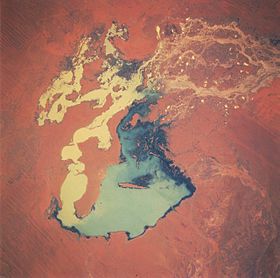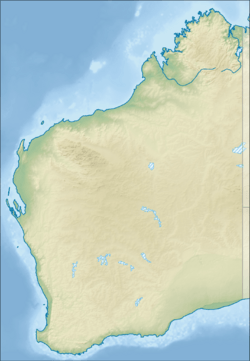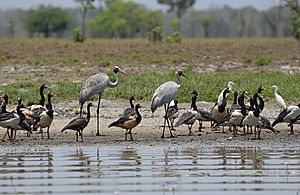Lake Gregory (Western Australia) facts for kids
Quick facts for kids Lake Gregory(Paraku) Paraku (Walmajarri) |
|
|---|---|

Lake Gregory from space, September 1993. The main body of the lake appears bluish-turquoise in the center of the picture. The multi-braided channels (upper right) that feed water into Lake Gregory from the northeast are part of the Sturt Creek drainage system. There appears to be an excess of standing water in the channels (muddy-looking, yellowish) north and west of the main part of the lake. The surrounding landscape consists of grasslands with numerous sand ridges (thin, dark, parallel lines on the lower left side of the image).
|
|
| Location | Kimberley, Western Australia |
| Coordinates | 20°12′S 127°27′E / 20.200°S 127.450°E |
| Type | Brackish water |
| Primary inflows | Sturt Creek |
| Primary outflows | internal drainage |
| Basin countries | Australia |
Lake Gregory, also known as Paraku in the Walmajarri language, is a special lake in Western Australia. It is located in the Kimberley region. You can find it between the Great Sandy Desert and the Tanami Desert.
The lake usually has slightly salty, or brackish, water. But after heavy monsoonal rains, it can become fresh. If there are many dry years, the water gets saltier.
Contents
Where is Lake Gregory?
Lake Gregory is about 220 kilometers (137 miles) south of Halls Creek. It sits where the Tanami Desert meets the Great Sandy Desert. The closest town is the Mulan Community, which is only 8 kilometers (5 miles) east of the lake.
The lake is very important to the Mulan Aboriginal Community. This is home to the Walmajarri people. The area has many culturally important sites for them. The Paraku Indigenous Protected Area works with the Walmajarri people. They help look after the lake and its surroundings.
What is Lake Gregory Like?
The lake is about 200 meters (656 feet) above sea level. It covers an area of about 400 square kilometers (154 square miles) when it floods. The lake's depth can change a lot, from 1 meter (3 feet) to 10 meters (33 feet) deep.
Lake Gregory is part of a larger system of water bodies. It gets most of its water from Sturt Creek. This creek has a huge area that collects water, about 65,000 square kilometers (25,097 square miles). Sturt Creek flows south and then splits into many smaller channels. These channels form a series of shallow, connected lakes.
The western part of Sturt Creek feeds into lakes like Rillya and Mulan Lake. Mulan Lake is the biggest. It can stay full for several years after the creek flows strongly. The bottom of Lake Gregory is mostly clay. You can also find some salt and gypsum pans there.
History of Lake Gregory
Long ago, about 300,000 years ago, Lake Gregory was part of a huge inland sea. This ancient sea was ten times bigger than the lake we see today. The lake's water levels depend on rain and water from Sturt Creek. Water leaves the lake only by evaporating or soaking into the ground. There is no river flowing out of the lake.
The lake was first called Gregory's Salt Sea on a map by Alfred Canning. He was surveying the Canning Stock Route. The lake was named after explorer Augustus Charles Gregory, who traveled through the area in 1856.
The land around the lake had lots of plants and animals. This attracted cattle farmers in the early 1900s. The Canning Stock Route was built in 1910. It was used to move cattle from the east Kimberley region. This route runs along the western side of the lake system.
Lake Gregory Station is a large cattle property. It covers 270,000 hectares (667,100 acres). In 2016, the Aboriginal Land Trust bought it. It is now leased to a cattle company.
In 2001, the High Court of Australia officially recognized the Walmajarri people. They were named the traditional owners of the land. A special ceremony was held at the lake to mark this event.
Archaeologists found ancient stone tools near Lake Gregory in 2008. These tools are at least 37,000 years old. This makes Lake Gregory one of the oldest known places where people lived in Australia.
Plants Around the Lake
The sandy plains around the lake have many types of shrubs. You can find Hakea species and desert bloodwoods. There are also different kinds of Acacia and Grevillea plants. These grow over soft, spiky grass called spinifex.
The areas along the creeks have different grasses. These include ribbon and Flinders grasses. You can also see tall River red gum trees there.
Birds of Lake Gregory
Lake Gregory is a very important place for birds. Many shorebirds stop here during their long migrations. It is also a major breeding spot for several types of water birds. These include cormorants and terns.
BirdLife International has named Lake Gregory an Important Bird Area (IBA). This means it is crucial for many bird species. For example, it supports over 1% of the world's populations of hardheads, grey teals, and pink-eared ducks. It also hosts many little black cormorants, brolgas, and sharp-tailed sandpipers.
Sometimes, the lake also supports large numbers of magpie geese and Pacific black ducks. More than 100,000 water birds regularly live at the lake. This is more than any other inland freshwater lake in Australia. In 1988, over half a million water birds were counted there! They belonged to at least 67 different species.



